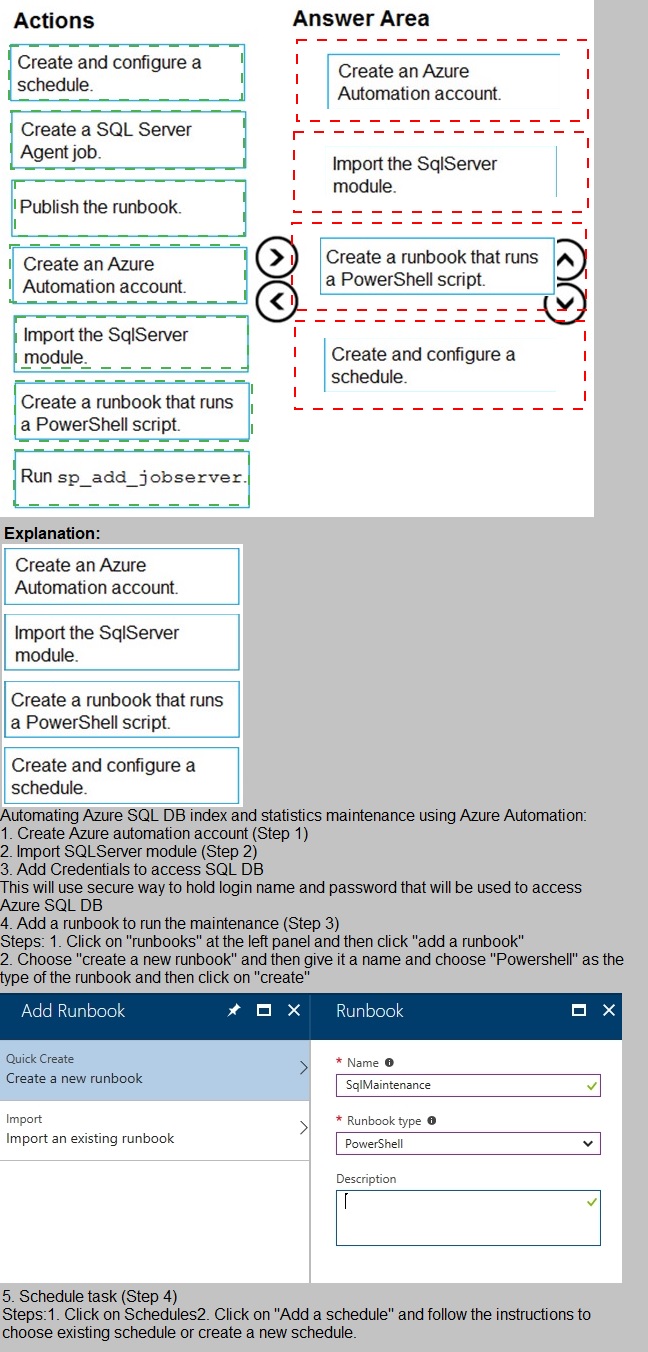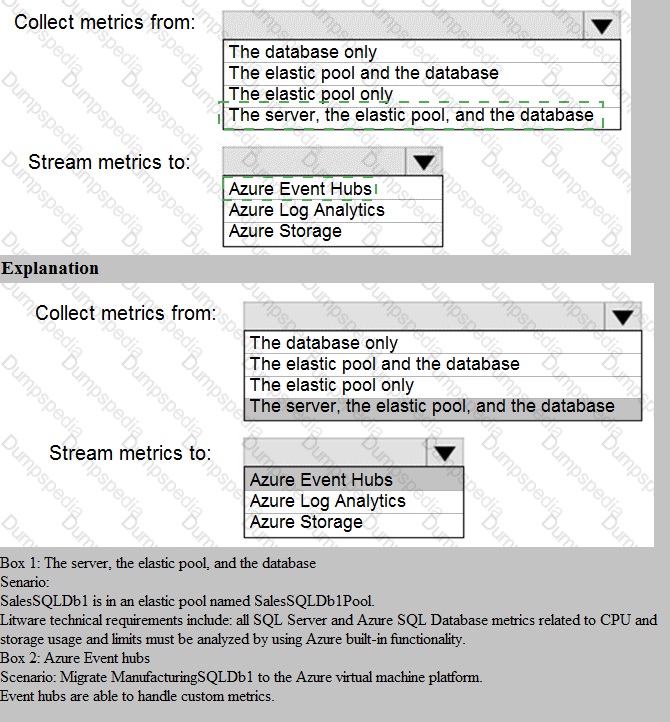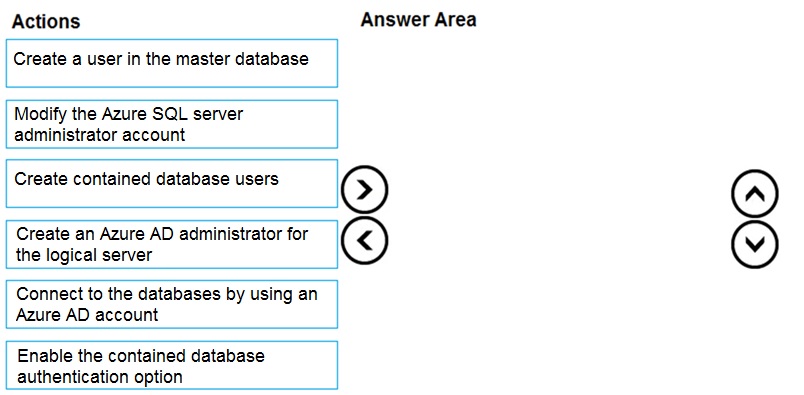Topic 1: Litware
Existing Environment Network Environment The manufacturing and research datacenters connect to the primary datacenter by using a VPN. The primary datacenter has an ExpressRoute connection that uses both Microsoft peering and private peering. The private peering connects to an Azure virtual network named HubVNet. Identity Environment Litware has a hybrid Azure Active Directory (Azure AD) deployment that uses a domain named litwareinc.com. All Azure subscriptions are associated to the litwareinc.com Azure AD tenant. Database Environment The sales department has the following database workload: An on-premises named SERVER1 hosts an instance of Microsoft SQL Server 2012 and two 1-TB databases. A logical server named SalesSrv01A contains a geo-replicated Azure SQL database named SalesSQLDb1. SalesSQLDb1 is in an elastic pool named SalesSQLDb1Pool. SalesSQLDb1 uses database firewall rules and contained database users. An application named SalesSQLDb1App1 uses SalesSQLDb1. The manufacturing office contains two on-premises SQL Server 2016 servers named SERVER2 and SERVER3. The servers are nodes in the same Always On availability group. The availability group contains a database named ManufacturingSQLDb1 Database administrators have two Azure virtual machines in HubVnet named VM1 and VM2 that run Windows Server 2019 and are used to manage all the Azure databases. Licensing Agreement Litware is a Microsoft Volume Licensing customer that has License Mobility through Software Assurance. Current Problems SalesSQLDb1 experiences performance issues that are likely due to out-of-date statistics and frequent blocking queries. Requirements Planned Changes Litware plans to implement the following changes: Implement 30 new databases in Azure, which will be used by time-sensitive manufacturing apps that have varying usage patterns. Each database will be approximately 20 GB. Create a new Azure SQL database named ResearchDB1 on a logical server named ResearchSrv01. ResearchDB1 will contain Personally Identifiable Information (PII) data. Develop an app named ResearchApp1 that will be used by the research department to populate and access ResearchDB1. Migrate ManufacturingSQLDb1 to the Azure virtual machine platform. Migrate the SERVER1 databases to the Azure SQL Database platform. Technical Requirements Litware identifies the following technical requirements: Maintenance tasks must be automated. The 30 new databases must scale automatically. The use of an on-premises infrastructure must be minimized. Azure Hybrid Use Benefits must be leveraged for Azure SQL Database deployments. All SQL Server and Azure SQL Database metrics related to CPU and storage usage and limits must be analyzed by using Azure built-in functionality. Security and Compliance Requirements Litware identifies the following security and compliance requirements: Store encryption keys in Azure Key Vault. Retain backups of the PII data for two months. Encrypt the PII data at rest, in transit, and in use. Use the principle of least privilege whenever possible. Authenticate database users by using Active Directory credentials. Protect Azure SQL Database instances by using database-level firewall rules. Ensure that all databases hosted in Azure are accessible from VM1 and VM2 without relying on public endpoints. Business Requirements Litware identifies the following business requirements: Meet an SLA of 99.99% availability for all Azure deployments. Minimize downtime during the migration of the SERVER1 databases. Use the Azure Hybrid Use Benefits when migrating workloads to Azure. Once all requirements are met, minimize costs whenever possible.
You need to implement statistics maintenance for SalesSQLDb1. The solution must meet
the technical requirements.
Which four actions should you perform in sequence? To answer, move the appropriate
actions from the list of actions to the answer area and arrange them in the correct order.

You need to recommend a configuration for ManufacturingSQLDb1 after the migration to
Azure. The solution must meet the business requirements.
What should you include in the recommendation? To answer, select the appropriate
options in the answer area.
NOTE: Each correct selection is worth one point.

You are planning the migration of the SERVER1 databases. The solution must meet the
business requirements.
What should you include in the migration plan? To answer, select the appropriate options in
the answer area.
NOTE: Each correct selection is worth one point.

You need to recommend the appropriate purchasing model and deployment option for the
30 new databases. The solution must meet the technical requirements and the business
requirements.
What should you recommend? To answer, select the appropriate options in the answer
area.
NOTE: Each correct selection is worth one point.

You need to identify the cause of the performance issues on SalesSQLDb1.
Which two dynamic management views should you use? Each correct answer presents
part of the solution.
NOTE: Each correct selection is worth one point.
A.
sys.dm_pdw_nodes_tran_locks
B.
sys.dm_exec_compute_node_errors
C.
sys.dm_exec_requests
D.
sys.dm_cdc_errors
E.
sys.dm_pdw_nodes_os_wait_stats
F.
sys.dm_tran_locks
sys.dm_pdw_nodes_tran_locks
sys.dm_pdw_nodes_os_wait_stats
Explanation:
SalesSQLDb1 experiences performance issues that are likely due to out-of-date statistics
and frequent blocking queries.
A: Use sys.dm_pdw_nodes_tran_locks instead of sys.dm_tran_locks from Azure Synapse
Analytics (SQL Data Warehouse) or Parallel Data Warehouse.
E: Example:
The following query will show blocking information.
SELECT
t1.resource_type,
t1.resource_database_id,
t1.resource_associated_entity_id,
t1.request_mode,
t1.request_session_id,
t2.blocking_session_id
FROM sys.dm_tran_locks as t1
INNER JOIN sys.dm_os_waiting_tasks as t2
ON t1.lock_owner_address = t2.resource_address;
Note: Depending on the system you’re working with you can access these wait statistics
from one of three locations:
sys.dm_os_wait_stats: for SQL Server
sys.dm_db_wait_stats: for Azure SQL Database
sys.dm_pdw_nodes_os_wait_stats: for Azure SQL Data Warehouse
Reference:
https://docs.microsoft.com/en-us/sql/relational-databases/system-dynamic-managementviews/
sys-dm-tran-locks-transact-sql
You need to implement the monitoring of SalesSQLDb1. The solution must meet the
technical requirements.
How should you collect and stream metrics? To answer, select the appropriate options in
the answer area.
NOTE: Each correct selection is worth one point.

You need to configure user authentication for the SERVER1 databases. The solution must
meet the security and compliance requirements.
Which three actions should you perform in sequence? To answer, move the appropriate
actions from the list of actions to the answer area and arrange them in the correct order.

What should you do after a failover of SalesSQLDb1 to ensure that the database remains
accessible to SalesSQLDb1App1?
A.
Configure SalesSQLDb1 as writable.
B.
Update the connection strings of SalesSQLDb1App1.
C.
Update the firewall rules of SalesSQLDb1.
D.
Update the users in SalesSQLDb1.
Update the firewall rules of SalesSQLDb1.
Scenario: SalesSQLDb1 uses database firewall rules and contained database users.
You need to implement authentication for ResearchDB1. The solution must meet the
security and compliance requirements.
What should you run as part of the implementation?
A.
CREATE LOGIN and the FROM WINDOWS clause
B.
CREATE USER and the FROM CERTIFICATE clause
C.
CREATE USER and the FROM LOGIN clause
D.
CREATE USER and the ASYMMETRIC KEY clause
E.
CREATE USER and the FROM EXTERNAL PROVIDER clause
CREATE USER and the FROM EXTERNAL PROVIDER clause
Which audit log destination should you use to meet the monitoring requirements?
A.
Azure Storage
B.
Azure Event Hubs
C.
Azure Log Analytics
Azure Log Analytics
Explanation:
Scenario: Use a single dashboard to review security and audit data for all the PaaS
databases.
With dashboards can bring together operational data that is most important to IT across all
your Azure resources, including telemetry from Azure Log Analytics.
Note: Auditing for Azure SQL Database and Azure Synapse Analytics tracks database
events and writes them to an audit log in your Azure storage account, Log Analytics
workspace, or Event Hubs.
Reference:
https://docs.microsoft.com/en-us/azure/azure-monitor/visualize/tutorial-logs-dashb
| Page 1 out of 22 Pages |